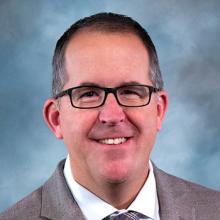This column is part of a series of firsthand physician accounts that detail how AMA Health System Member Programs are moving medicine to support patient health and the medical profession.
One of the most frequent issues I hear about from our physicians at Confluence Health is the significant burden placed on them by our EHR system. Stories of physicians spending long hours charting into the night, getting buried by patient messages, and feeling like data-entry clerks rather than highly skilled clinicians have become all too common across the health care landscape.
However, at Confluence Health in North Central Washington, we've been making meaningful strides to buck that trend and reduce the EHR burden for our physicians. As participants in the AMA’s Joy in Medicine Health System Recognition Program, we have been calculating EHR time-based measures for the last two years—indexed to eight hours of scheduled appointments.
Over the past few years, we've implemented a range of measures that have collectively produced dramatic improvements in reducing our physicians' EHR-related workloads and restoring their work-life balance. No doubt this has helped cut our family physician burnout rate from 41% to 26% in the most recent survey.
One of the most striking enhancements we've achieved is a significant reduction in time our primary care physicians spend using the EHR. Our family doctors and internists have seen the amount of time they spend in the EHR drop by an average of 34 minutes per eight-hour clinic day.
Even more impressively, half of this improvement was in time spent working in the EHR after hours, often called pajama time. Overall, we spend about 17% less time in the EHR (326 minutes, which is a 65 minute difference) and about 67% less time after hours (54 minutes, which is a 112 minute difference) compared with figures reported by researchers from the AMA and elsewhere in the medical literature.
In addition to reducing the amount of time spent in the EHR, we've also made great strides in decreasing another widespread burden plaguing health care organizations: patient portal messages. While there has been a massive growth in these asynchronous digital interactions starting with COVID-19, we've actually reduced the volume of portal messages per patient. Our physicians get only about one-third as many portal messages, compared with the experience of physicians across the health care industry as reported by researchers from the AMA and elsewhere in medical literature.
We have achieved this without burdensome patient-messaging fees by optimizing processes, reducing extraneous notifications and empowering support teams to tackle routine tasks, in line with great resources from the AMA on taming the EHR inbox. Most importantly, we’ve worked hard to set expectations on appropriate portal use for patients, physicians and staff. We no longer speak of “messaging your doctor” but have changed this language to “message your physician’s office” to ensure a team-based focus.
Coordinated efforts help cut clicks
These achievements are not the product of any single silver bullet, but rather an accumulation of small, intentional and coordinated optimization efforts across our health system. These include fostering a culture of ongoing EHR training and efficiency mentorship, standardizing repeatable clinical workflows, and making judicious technological enhancements backed by robust change management. Each of these initiatives has contributed an incremental improvement.
Some of that work includes reordered message options, added self-service options, routing to pools, MyChart user guide, auto-closing of message strings, online scheduling and filtering out “thank you” messages.
These improvements are the result of close collaboration between clinical informatics, physician well-being leadership, our training team and front-line physicians and other health professionals who identify and address areas of EHR-related frustration.
Using a variety of communication methods, we have empowered our physicians and staff to voice their concerns and provide real-world input to guide our priorities. And we've remained focused on holistic solutions that balance the technical capabilities of our EHR with the essential need to achieve physician satisfaction and patient engagement.
There’s more work to do
While we certainly don't have a magic solution to eliminate the universal challenges of EHR burden, we have made meaningful progress in taming the beast and rehumanizing the practice of medicine. Our work continues daily, with consistent communication, monitoring and a commitment to continuous improvement.
For our physicians, these efforts have enabled them to spend more time focused on why they went into medicine: caring for patients. And for our patients, they experience the calming reassurance of having an attentive, present and fulfilled physician in the exam room.
There's still a long road ahead as we continue enhancing our EHR while keeping vigilant to prevent new inefficiencies from arising. But our experience so far has demonstrated that with discipline, teamwork and an unwavering, patient-centric philosophy, it is possible to reduce EHR burden in meaningful ways.
Dr. Mahnke is a pediatric cardiologist and clinical informaticist with over 20 years of experience in health IT. At Confluence Health, he has led initiatives to improve EHR end-user satisfaction, clinical analytics utilization, and clinical efficiency.




